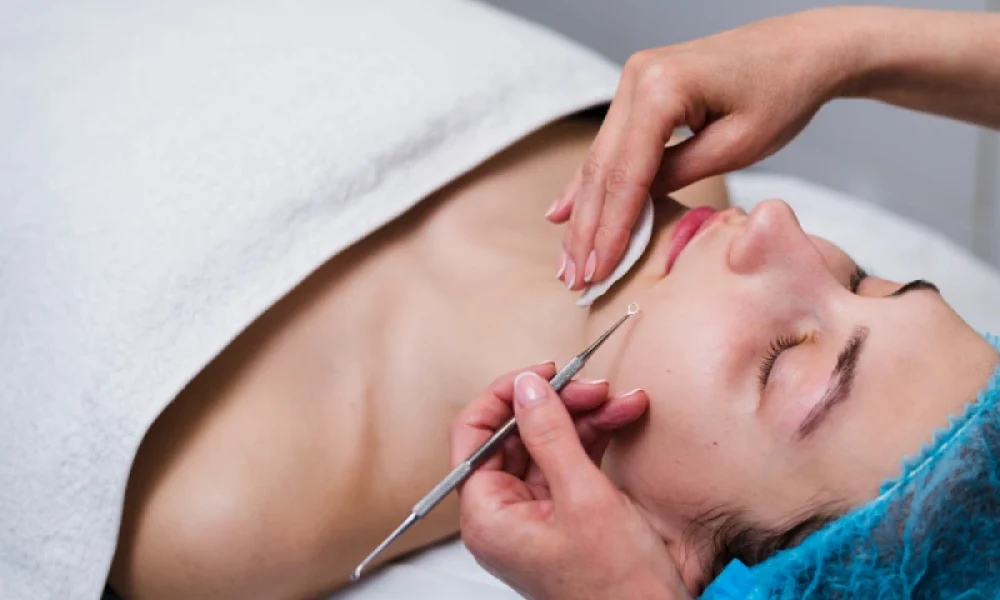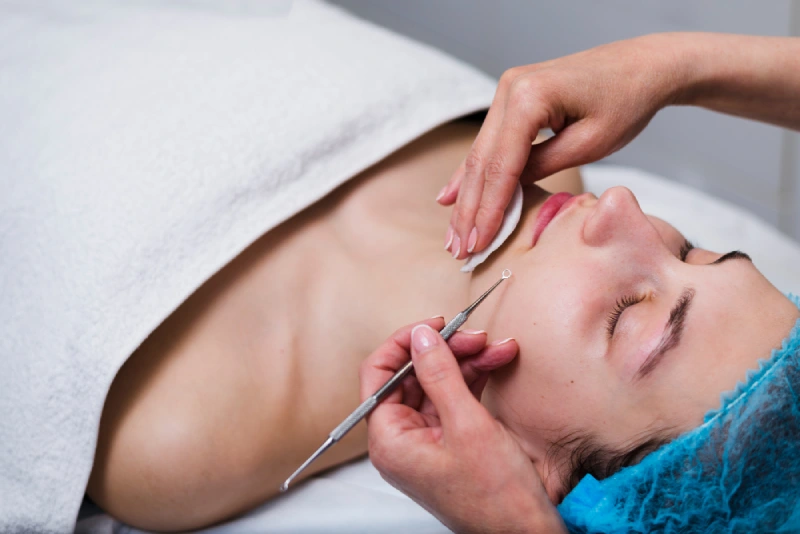What Are Benign Skin growths/lesions?
Benign skin growths or lesions are non-cancerous skin abnormalities that can occur anywhere on the body. These lesions can manifest in a variety of ways, based on their cause and tissue of origin.
Common benign skin growths are melanocytic nevi, skin tags, moles, lipomas, seborrheic keratoses, and cherry angiomas. Mostly, benign growths are harmless and don’t need any treatment unless they cause symptoms such as growth, tenderness, itch or discomfort, or you desire them to improve your appearance by removing them.
Other common benign growths or bumps are: Milia, Cosmetic moles, Sebaceous hyperplasia, and syringomas.
What Do They Look Like?
Benign lesions are usually stable, well-circumscribed, symmetrical, have a uniform appearance, and may grow slowly over time. But, it can be hard to differentiate benign lesions from malignant lesions like skin cancers in particular situations. In such scenarios, our expert dermatologists perform a biopsy or surgically remove the affected areas to rule out the possibility of malignancy.
Benign lesions must be differentiated from premalignant lesions such as lentigo maligna or actinic keratosis, which feature a high risk of developing into skin cancer. Both lentigo maligna and actinic keratosis happen as a result of sun exposure. Lentigo maligna can appear as a black or dark-brown spot predominantly on the trunk or face and Actinic keratoses can appear as scaly, dry patches of skin over sun-exposed areas like the forehead and nose. These lesions are different from benign ones because they tend to worsen over time and do not go away on their own..
How do we Diagnose Different Benign Skin Growths?
For the diagnosis of benign skin lesions, it’s crucial to find out their history, how long the lesions have been there, whether or not there are any symptoms, and whether or not they are changing their structure, shape or color. A full skin examination is mandatory in most patients and our dermatologists perform dermoscopy with the help of a 10-fold magnification device. Sometimes, when the lesion is unable to be diagnosed with a skin exam, they perform a skin biopsy to remove and diagnose the spot.
If the lesion appears to be malignant, we biopsy it to diagnose the type of skin cancer, then perform an excision to remove it, and refer to a Mohs specialist for more delicate areas. There are several other procedural and non-surgical treatments for skin cancers your specialist will discuss with you once your results are available. When the patient is concerned about the cosmetic appearance of a mole, these skin lesions can be surgically removed or excised.
We use multiple approaches to treat benign lesions and bumps depending on the size, location and depth. We use the following treatment options:
- Heat treatment (Electrocautery)
- Laser treatment
- Biopsy
- Shave removal
- Cosmetic removal
- Topical creams
How Do You Treat Skin Lesions?
Treatment of benign skin lesions (when there are no symptoms of malignancy) is sometimes no treatment at all. They can be managed by regular check-ups with your dermatologist or medical practitioner. If required, we can provide local treatment to skin lesions with topical medications such as retinoids and prescription creams as well as cryotherapy, laser therapy, surgical removal or electrocautery to remove the lesion. If the reason for the skin lesion was a systemic disease, we may recommend treating it by addressing the underlying causes.
Benign Skin Lesion Removal
The skin lesion removal process is performed in a dermatologist’s office. Our dermatologists perform benign skin lesion removal procedures depending on the size, location and type of the lesion. The removed lesion is usually sent to an outside lab for thorough examination and diagnosis under the microscope. You may be given some type of numbing medicine before the removal process. Here are the different types of skin removal techniques that our dermatologists use:
Shave Removal:
We use this technique for skin lesions that grow over and above the skin. The doctor uses a small blade for the removal of the outermost/upper layer of the skin after numbing that specific area. We completely remove the lesion from the skin. A patient usually doesn’t need stitches after this treatment. At the end of the procedure, we apply the medicine to that particular area to stop any bleeding. Sometimes, we need to treat it with cautery to stop the bleeding. This technique has minimal pain and no downtime. The area heals within 7-10 days with gentle wound care.
Simple Scissor Excision
We use simple scissor excision for skin lesions removal that grow in the upper layer of the skin. Your dermatologist will use small forceps to lightly pull up the skin. They will use small scissors to carefully snip the lesion. No stitches will be needed. At the end of the procedure, your doctor will apply medicine to that area to stop bleeding. Or they may treat the area with cautery. This technique has minimal pain and no downtime.
Skin Excision
This procedure is used for lesions that have grown in the deeper skin layers and may have roots in the fatty layer of skin. A small portion of normal tissues around the lesion are removed to ensure it’s clear of any malignant cells. This is mostly done when there’s a risk of skin cancer or when it is a deeper benign lesion like a cyst or lipoma.
- Normally, we remove an area with the shape of an ellipse, as this makes the stitching process more effective at the end.
- We remove the entire lesion while going as deep as the fat, if mandatory, to clear the whole area. We also remove a 3-4 millimeters margin or more surrounding the tumor to make sure that the margins are clear.
We then close the area with stitches. If we need to remove a large area, a flap of normal skin or a skin graft may be used to replace the removed skin. This technique has minimal pain after lidocaine is used for pain control. The stitches stay in for 2 weeks, and we advise you to refrain from heavy exercising for up to 4 weeks. After that, the wound is stronger, and you can go back to your daily activities.
Curettage and Electrodesiccation
In this process, we scrape or scoop out a skin lesion. This is a technique that involves the use of high-frequency electrical current, known as ELECTRODESICCATION, which may be used before or after. This technique can be used for benign lesions as well as some superficial skin cancers. There is minimal pain after lidocaine for numbing and no need to refrain from exercise. It takes 1-2 weeks to heal after this procedure.
Laser removal
A laser is a light beam that is used to focus on a very small area, and it can treat different types of skin concerns. The laser heats that particular area that needs treatment until the lesion is removed. There are various types of lasers. Each laser has a particular use. They can be used to treat warts, premalignant skin lesions or benign lesions, hair, tattoos, sunspots, dark spots, angiomas, hyperpigmentation, redness, hyperpigmentation or dark spots, and small blood vessels in the skin.
Cryotherapy
Cryotherapy is a process that involves gently freezing the skin in order to destroy the lesion. It is usually used to remove or destroy warts, seborrheic keratoses, actinic keratoses and molluscum contagiosum. We spray the lesion with a small nozzle attached to a spray canister containing liquid nitrogen. The process usually takes seconds. The freezing may sting a little. Your dermatologist may also apply numbing medicine to the lesion and its surrounding areas. After the cryotherapy, the treated area may blister and gentle wound care is needed.
Lesion removal is done to improve a person’s appearance or if the lesion is causing discomfort or irritation. Your dermatologist may suggest the removal of a lesion if you have:
- Molluscum contagiosum
- Bowen’s disease
- Actinic keratosis
- Skin tags
- Lipoma
- Moles
- Warts
- Benign Growth
Book An Appointment Today With Our Dermatology Specialists at Nature of Skin Dermatology in Austin, Texas
Struggling with unwanted blemishes? We will help you take back control of your skin with our exceptional Benign skin lesion removal services. We understand that skin lesions can badly affect your self-esteem and confidence. That’s why we have a dedicated team to deliver the safest, most effective and most advanced treatments for an array of benign skin anomalies. Whether you have skin tags, moles or any other benign growth, we will approach them with care, precision and expertise. Dive into a world where the well-being of your skin is the top priority. Don’t let benign lesions dictate your comfort in your skin any longer. Choose Nature of Skin Dermatology today and enjoy smoother, radiant, clear skin.
Book your consultation today and discover a blemish-free, brighter tomorrow.
Frequently Asked Questions
- How do dermatologists remove skin growths?
Our dermatologists use a small blade or tool to remove the upper layers of skin after making the area numb. We remove that particular area from the surface of the skin. A patient usually doesn’t need any stitches and it’s a generally comfortable procedure.
- Should Benign skin growths be removed?
Most benign skin lesions can be safely left untreated. However, you may want the skin lesion removed for cosmetic concerns or to ensure that it’s not cancerous.
- Which is the most common benign skin growth?
The most common benign skin lesion is a “Seborrheic Keratosis.” They are brown (hyperpigmented), and scaly (hyperkeratotic) bumps or plaques that often vary in thickness and size and usually appear to be stuck on skin.
- Do benign skin growths need surgery?
Generally, the growth of a benign tumor is slow and some of them never need treatment. However, some may cause severe health risks when they press on nearby blood vessels, nerves or organs, or grow on the spinal cord or the brain. These forms of tumors usually need surgery to be removed.
Disclaimer: The information provided on the site is for educational purposes only, and does not substitute for professional medical advice. Consult a medical professional or healthcare provider if you are seeking medical advice, diagnoses, or treatment.





